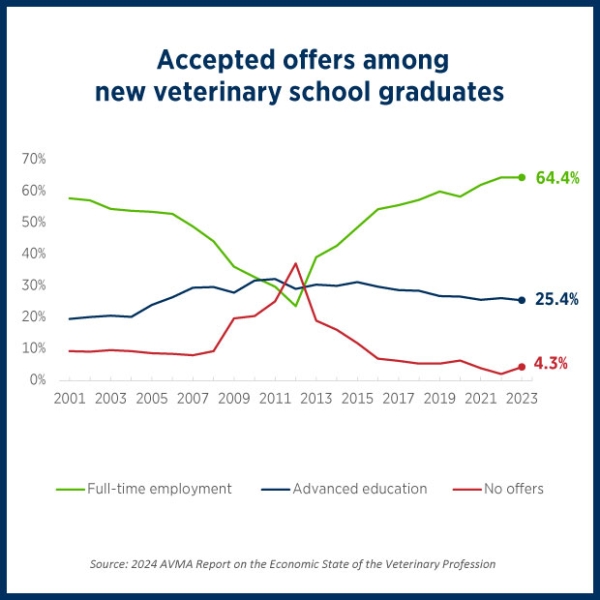Chart of the Month: Good news on student debt
It’s always nice to be able to report good news—and in terms of new veterinary school graduates, there’s good news around student loan debt.
As today's Chart of the Month shows, the debt burdens of new graduates have been going down for a few years, setting new veterinarians up for stronger financial futures.
What do the data show?
After reaching a peak in 2020, the amount of student debt owed by new graduates has been on the decline for the last two years.
Mean student debt for veterinary graduates
In 2022, the average student debt for all graduates was $147,258, down more than 6% from 2020. Excluding graduates who got through their schooling without taking out any educational loans, the average debt balance for those who did have loans was $179,505, down 5% from 2020. Another key measure of debt: 18% of 2022 graduates indicated that they finished their veterinary education with no debt.
Something else is down, too: the debt-to-income ratio for these graduates. That means that the Class of 2022, as a whole, is better able to pay down their student loans than were the veterinary graduates who preceded them in recent years.
As debt levels have fallen in the last two years, starting salaries have been going up. Now, the average debt-to-income ratio stands at 1.44 for 2022 graduates entering full-time employment, coming in very close to the 1.4 figure considered serviceable for a new graduate to pay down without inducing serious financial stress. That’s a substantial improvement from last year, as the 2021 cohort had a debt-to-income ratio of 1.7.
What do the data mean?
The recent reductions bring average debt burdens back down to levels last seen prior to 2018, providing some welcome relief for new graduates. They’re an encouraging sign that the Class of 2022, as a group, is better positioned for financial success than their recent predecessors.
There’s still much room for improvement, though.
- The 2022 graduating class is near, but not at, the targeted debt-to-income ratio of 1.4.
- Within the group, many graduates had much higher debt levels than the average. A sobering reality: more than a quarter of the class had a debt-to-income ratio of 2.0 or more.
- The lower debt obligations facing these new graduates don’t in any way mitigate the much larger student debt burdens accumulated by their predecessors who are further along in careers and still struggling to pay off loans.
Tackling student debt
Regardless where you are in your career, the AVMA has resources to help you identify the best strategy to pay down your student debt. These include a CE webinar on repayment options and strategies, which is available free of charge to all AVMA members. The AVMA’s My Veterinary Life website also provides numerous resources related to managing student debt, customized for different career stages:
- Current students
- New graduates
- Rising professionals
The AVMA’s economics team explored the student debt numbers in more detail in a recent article in dvm360 magazine: Recent veterinary graduate compensation up, debt down.
How AVMA’s advocacy work helps
Along with providing practical tools, the AVMA is committed to developing public policy solutions that reduce veterinary debt. Here’s what the AVMA is doing in Washington to support veterinary borrowers and combat high levels of veterinary student debt.




Comments
While this is good news and…
While this is good news and some progress had likely been made, this article skips a major contributing factor: COVID-19 and the student loans interest pause. Interest rates on federal student loans may not seem like much (in comparison to other loans, mortgages, or credit cards), but on the principle amounts that are typically withdrawn and that the interest usually starts accruing during the student’s years at school, it adds up and fast!!! Without taking this into consideration, I feel a sense of false short-lived hope is being created. Truthfully, the graduating years that were in school at any point during the pandemic, can’t be included in the overall debt amount conversation without this important caveat. Sure, we can talk about the other factors (like debt-to-income, how many are debt free versus otherwise), but even those won’t be truly reflective of the non-pandemic graduating years to come, especially if larger changes aren’t made to address student loans and interest going forward.
Types of non profit employment
Does the veterinarian have to be a w2 employee or is a 1099 sufficient for qualification in the forgiveness program ?
Add New Comment